August 18, 2010
Real Or Fake? (Fake.)
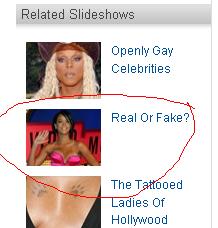
a corollary to Parkinson's Law of Triviality
If you have trouble following my rants about misdirection and manipulation in the media, this is a good example of the mechanism. Don't be fooled by the triviality of it.
It's a slideshow called "Real Or Fake." Look closely.
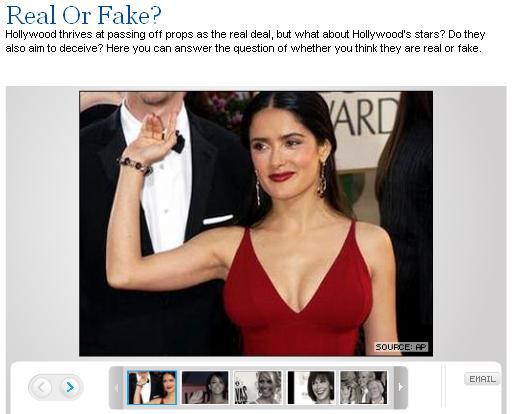
FYI: the answer is real.
You can see at the bottom the rest of the people are Rihanna, Pam Anderson, Jennifer Love Hewitt, Playboy Playmates, etc.
But rather than the slideshow being about the obvious-- about the thing that got me to go to it-- it pretends to be about something else:

Ooh. Tricky. And it continues in this vein:
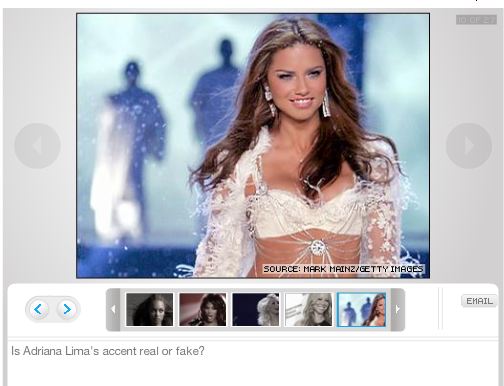
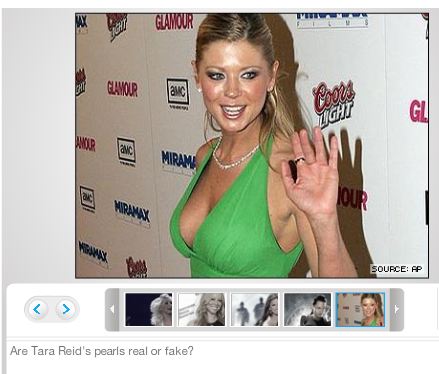
Get it? Bait and switch, without the switch.
You are enticed to look at it because it makes you think it's about famous women's boobs. But CBS can't just become the CW, it has big brand advertisers it needs to satisfy with its high level of integrity. Acura isn't paying just for eyeballs, it's paying for positioning and loyalty. "The kind of person who likes CBS is the kind of person who likes Acura." And vise versa. So the captions afford it plausible deniability even as they pull in the internet clicks.
And there are plenty of clicks. Go to the CBS site-- the same slideshow is playing on CBS affiliates throughout the land-- and scroll through the 27 slide show (turn off your adblock.) Every new slide refreshes the ads. So if each ad pays $x per 1000 displays, the slideshow has the potential to bring in $27x.
It's the same with the NYT or any other site that has multiple pages to a single article that you need to click through-- all of those allow the ads to refresh.
 So an article of $x can potentially generate $4x.
So an article of $x can potentially generate $4x.
II.
In Network, the news division simply didn't bring in the revenue like an entertainment show did; but it was argued that the news division is too important, profit be damned. Is that realistic? No. It makes tons of money for the network.
The primary motive for the media company (not the individual news outlet) is to draw in ad money and traffic. So an unwatched show on CBS like the Miss Universe Pageant generates tons of money for CBS in other ways (e.g. Access Hollywood. "You'll never believe what happened!" I didn't think I cared what happened, but I guess I do?)
Same with the news. The news can legitimize a story sufficiently to allow it to get play everywhere else on the network. "CBS News is reporting that Mel Gibson..." Or it can play in the reverse. Rolling Stone magazine is expected to have the naked cast of True Blood on their cover, CBS News couldn't get away with that. Solution? CBS News does a story about the Rolling Stone cover, which in turn legitimizes it further.
All "shows" are responsible to their advertisers (not the public) but in a way that circumvents clear accountability. Does Acura really want a fake boobs story on CBS? No. But would it allow a "how celebrities deceive their public?" story? Go get 'em.
So the news wants to give you pornography, but it still has to pretend it is giving you information.
III.
For example (British paper The Daily Mail):
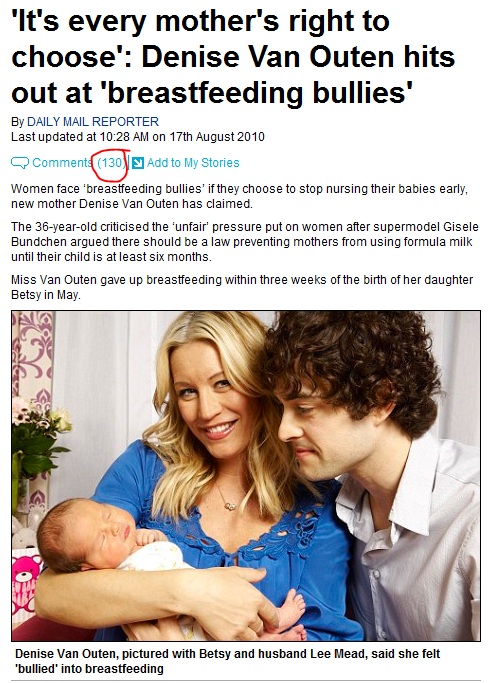
So why would a newspaper want to publish a story about a woman upset about breastfeeding bullies?
They wouldn't; the only part of the story that makes it interesting to them is that the bully is supermodel Gisele. Without the link to Gisele, the article has no draw.
But even so, why would a paper care what some mom thinks about what Gisele says? It would only do so if the "mom" was some kind of a celebrity herself already; and Denise is apparently some kind of celebrity over in the UK, having judged a talent show and been naked in public.
Meanwhile, how does a D list celebrity keep herself in the spotlight post baby? Not by talking about breastfeeding (meh) but by attacking Gisele (oooohhh!)
For clarification, the real reason Denise doesn't breast feed is:
That's media today. The story is used by Denise to keep herself in the spotlight and then by the publisher as three kinds of linkbait: Denise, Gisele, and breastfeeding.
The point that must be emphasized is that the purpose of the story is to get you to go there. That's it.
III.
I've chosen silly examples to make the method obvious and the purpose clear.
A more subtle example of this manipulation is the current controversy over the "Mosque at Ground Zero." This is manufactured controversy if there ever was one, but instead of being being manufactured by politicians for political purposes, it's by media for the purposes of bringing in clicks.
Never mind it's not at Ground Zero. It's two blocks away, well guarded by St. Peter's Church, The Department of Health, and the University of Phoenix. Feel safer? Furthermore, the Amish are stationed right next door.
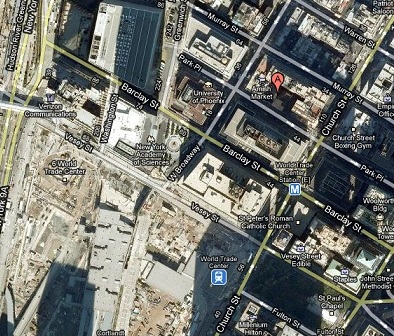
And never mind that it is already a mosque. Another mosque four blocks from Ground Zero got full, and so they were having services at the Burlington Coat Factory-- the site of the proposed mosque.
The only thing that matters is keeping the controversy alive so that people go to the story. Fox will tell you it's at Ground Zero, CNN will be careful to mention that it's only near Ground Zero, but anyone is free to use the controversy to bring in the clicks:


etc.
Interestingly, the CS Monitor gets it exactly right, I'm sure by accident:

----
http://twitter.com/thelastpsych
It's a slideshow called "Real Or Fake." Look closely.

FYI: the answer is real.
You can see at the bottom the rest of the people are Rihanna, Pam Anderson, Jennifer Love Hewitt, Playboy Playmates, etc.
But rather than the slideshow being about the obvious-- about the thing that got me to go to it-- it pretends to be about something else:

Ooh. Tricky. And it continues in this vein:


Get it? Bait and switch, without the switch.
You are enticed to look at it because it makes you think it's about famous women's boobs. But CBS can't just become the CW, it has big brand advertisers it needs to satisfy with its high level of integrity. Acura isn't paying just for eyeballs, it's paying for positioning and loyalty. "The kind of person who likes CBS is the kind of person who likes Acura." And vise versa. So the captions afford it plausible deniability even as they pull in the internet clicks.
And there are plenty of clicks. Go to the CBS site-- the same slideshow is playing on CBS affiliates throughout the land-- and scroll through the 27 slide show (turn off your adblock.) Every new slide refreshes the ads. So if each ad pays $x per 1000 displays, the slideshow has the potential to bring in $27x.
It's the same with the NYT or any other site that has multiple pages to a single article that you need to click through-- all of those allow the ads to refresh.
II.
In Network, the news division simply didn't bring in the revenue like an entertainment show did; but it was argued that the news division is too important, profit be damned. Is that realistic? No. It makes tons of money for the network.
The primary motive for the media company (not the individual news outlet) is to draw in ad money and traffic. So an unwatched show on CBS like the Miss Universe Pageant generates tons of money for CBS in other ways (e.g. Access Hollywood. "You'll never believe what happened!" I didn't think I cared what happened, but I guess I do?)
Same with the news. The news can legitimize a story sufficiently to allow it to get play everywhere else on the network. "CBS News is reporting that Mel Gibson..." Or it can play in the reverse. Rolling Stone magazine is expected to have the naked cast of True Blood on their cover, CBS News couldn't get away with that. Solution? CBS News does a story about the Rolling Stone cover, which in turn legitimizes it further.
All "shows" are responsible to their advertisers (not the public) but in a way that circumvents clear accountability. Does Acura really want a fake boobs story on CBS? No. But would it allow a "how celebrities deceive their public?" story? Go get 'em.
So the news wants to give you pornography, but it still has to pretend it is giving you information.
III.
For example (British paper The Daily Mail):

So why would a newspaper want to publish a story about a woman upset about breastfeeding bullies?
They wouldn't; the only part of the story that makes it interesting to them is that the bully is supermodel Gisele. Without the link to Gisele, the article has no draw.
But even so, why would a paper care what some mom thinks about what Gisele says? It would only do so if the "mom" was some kind of a celebrity herself already; and Denise is apparently some kind of celebrity over in the UK, having judged a talent show and been naked in public.
Meanwhile, how does a D list celebrity keep herself in the spotlight post baby? Not by talking about breastfeeding (meh) but by attacking Gisele (oooohhh!)
For clarification, the real reason Denise doesn't breast feed is:
"I can't be sitting in Starbucks and breast feeding, because they (photographers) are taking pictures."
That's media today. The story is used by Denise to keep herself in the spotlight and then by the publisher as three kinds of linkbait: Denise, Gisele, and breastfeeding.
The point that must be emphasized is that the purpose of the story is to get you to go there. That's it.
III.
I've chosen silly examples to make the method obvious and the purpose clear.
A more subtle example of this manipulation is the current controversy over the "Mosque at Ground Zero." This is manufactured controversy if there ever was one, but instead of being being manufactured by politicians for political purposes, it's by media for the purposes of bringing in clicks.
Never mind it's not at Ground Zero. It's two blocks away, well guarded by St. Peter's Church, The Department of Health, and the University of Phoenix. Feel safer? Furthermore, the Amish are stationed right next door.

And never mind that it is already a mosque. Another mosque four blocks from Ground Zero got full, and so they were having services at the Burlington Coat Factory-- the site of the proposed mosque.
The only thing that matters is keeping the controversy alive so that people go to the story. Fox will tell you it's at Ground Zero, CNN will be careful to mention that it's only near Ground Zero, but anyone is free to use the controversy to bring in the clicks:


etc.
Interestingly, the CS Monitor gets it exactly right, I'm sure by accident:

----
http://twitter.com/thelastpsych
64 Comments